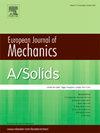Analysis of linear free and forced vibrations of microbeams with thermoelastic damping
IF 4.4
2区 工程技术
Q1 MECHANICS
引用次数: 0
Abstract
Thermoelastic damping is a crucial mechanism of energy dissipation in microbeams and has been widely considered by microelectromechanical systems (MEMSs) researchers. However, more research is required on the connections between microbeam parameters and thermoelastic vibrations. In this paper, we investigate the effects of the coefficient of thermal expansion (CTE) and the thermal conductivity (TC) on the microbeam's linear free and forced vibrations through the partial differential equations (PDEs), which include a scale-dependent microbeam model and the Fourier transport equation. First, the ordinary differential equations (ODEs) are obtained by applying the Galerkin method to the PDEs at the first-order bending and heat transport modes. Then, the precise analytical solutions of the ODEs are obtained to illustrate the relationships of the bending and temperature vibrations. The solutions reveal three significant results: (1) The mechanical energy dissipation in free vibrations increases with the increment of the CTE and the TC; (2) The CTE's augmentation decreases amplitudes of the bending vibrations but increases the amplitudes of temperature vibrations under forced vibrations. (3) The amplitudes of bending and temperature vibrations decrease with the TC's increment; simultaneously, the TC does not change the load's frequency corresponding to the most vibration amplitude under the forced vibrations.

热弹性阻尼是微梁能量耗散的重要机制,已被微机电系统(MEMS)研究人员广泛考虑。然而,关于微梁参数与热弹性振动之间的联系还需要更多的研究。在本文中,我们通过偏微分方程(PDEs)研究了热膨胀系数(CTE)和热导率(TC)对微梁线性自由振动和受迫振动的影响,偏微分方程包括与尺度相关的微梁模型和傅里叶传输方程。首先,通过对一阶弯曲和热传输模式的偏微分方程应用 Galerkin 方法,得到常微分方程 (ODE)。然后,得到 ODE 的精确解析解,以说明弯曲和温度振动的关系。解法揭示了三个重要结果:(1) 自由振动中的机械能耗散随 CTE 和 TC 的增加而增加;(2) CTE 的增加降低了受迫振动下的弯曲振动振幅,但增加了温度振动振幅。(3) 弯曲振动和温度振动的振幅随 TC 的增大而减小;同时,TC 不会改变强制振动下与最大振幅相对应的负载频率。
本文章由计算机程序翻译,如有差异,请以英文原文为准。
求助全文
约1分钟内获得全文
求助全文
来源期刊
CiteScore
7.00
自引率
7.30%
发文量
275
审稿时长
48 days
期刊介绍:
The European Journal of Mechanics endash; A/Solids continues to publish articles in English in all areas of Solid Mechanics from the physical and mathematical basis to materials engineering, technological applications and methods of modern computational mechanics, both pure and applied research.

 求助内容:
求助内容: 应助结果提醒方式:
应助结果提醒方式:


